The much-advertised English drama Mata.Mata has finally made its debut on Channel 5 last night.
Mata refers to eye in Malay, but mata-mata generally means policeman (or watchman), where a patrolling policeman of the olden days was the “one on all eyes”. The local Chinese “borrowed” the word and instead used the shortened version to refer to police. “mata chu“, for example, refers to the police station. Like the word “kopitiam“, it is a unique mixture of Chinese dialects and Malay that is not found anywhere else except Singapore and Malaysia.
The Early Police Force (1819-1826)
When Sir Stamford Raffles founded Singapore as a trading post, he assigned Singapore’s first Resident William Farquhar to be in-charge of the new colony’s law and order. In 1820, Singapore’s first true police force was established under the command of Police Chief Francis James Bernard, William Farquhar’s son-in-law. At the start, he had 11 staff – a sergeant, eight constables, a jail warden and a Malay administrator – and a monthly operating budget of 300 Indian rupees.
The First Police Station
The first police station, however, only came into existence three years later. Francis James Bernard built his residence at the southern bank of the Singapore River in 1823, which double functioned as the Police Office with a basement room for prisoners. In the same year, anti-arms laws were passed to forbid all residents on the island to carry weapons, with the exception of the Johor Sultan’s guards.
Straits Settlements Police (1826-1946)
When the British merged Singapore with Penang and Malacca to form the Straits Settlements in 1826, the police force in Singapore became part of the Straits Settlements Police Force until its disbandment in 1946.
Different Police Departments
As the settlement progressed and population grew, more police departments had to be established for different specialised roles. The Marine Police was one of the earliest to be formed. With two sampans, a 15-men force (a sub-Inspector, two corporals and 12 constables) and headquarters at the Cavanagh Bridge Police Station, it was set up in 1824 to combat against piracy near the Singapore harbour.
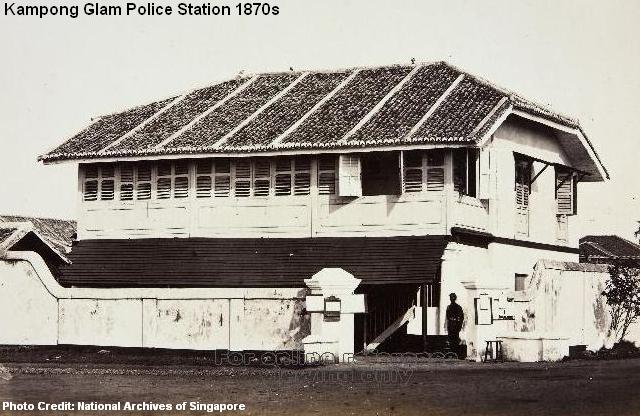
The increasing number of secret societies also prompted the police to establish the Detective Branch in 1886, which was later renamed as the Criminal Investigation Department (CID) in 1903. The Police Coast Guards was formed in 1916, followed by the Traffic Police two years later to control and regulate the traffic.
In dealing with seditious activities, the police set up the Criminal Intelligence Department in 1925. The same year also saw the formation of the first Police Force Band. By 1925, the construction of a Police Training School was completed at Thomson Road. The Communications Branch was set up in 1936, while the first batch of Auxiliary Police was recruited in 1939.
Singapore’s Early Riots
One of Singapore’s earliest riots occurred in 1854 when two leading Chinese secret societies clashed. Started from a quarrel over a bag of rice, it quickly escalated into widespread riots between the Hokkien-dominated Ghee Hock against Ghee Hin, backed by the Teochews. As many as 5,000 men fought on the streets for eight days, resulting in the death of 400 Chinese, dozens of shops looted and some small villages destroyed.
Without proper trainings, the small police force were inefficient and incapable of dealing with the unexpected conflicts. Many local residents had to be recruited as special constables to work with the military troops, who were brought in from the British navy ships for the peace-keeping.
Rise of Colonial Police Stations
The late 1920s and early 1930s were important periods in the history of the local police force. The British colonial government decided to invest huge amount of money in the construction of police stations and training barracks in many parts of Singapore in a battle against the Chinese secret societies and triads.
New stations, depots and staff quarters were erected at Thomson Road, Maxwell Road, Beach Road, Havelock Road, Tanjong Pagar, Bukit Panjang, Sepoy Lines, Kandang Kerbau, Joo Chiat and Woodlands. Two of the most prominent projects belonged to the new Hill Street Police Station and the extension of the Central Police Station.
Central Police Station, South Bridge Road
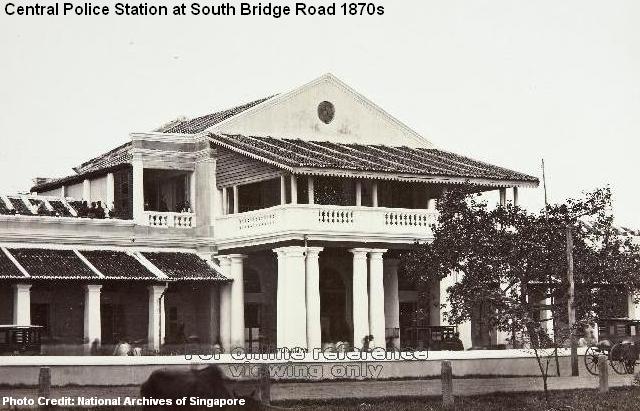
The history of the Central Police Station dated back to 1867, the same year Singapore was established as a British crown colony. It was strategically located at South Bridge Road to function as a police base against the secret societies that had plagued Chinatown for decades.  By the late 1920s, the British government decided to splash $144,000 on a new Central Police Station.
By the late 1920s, the British government decided to splash $144,000 on a new Central Police Station.
The main administrative office of the original police station was retained; new three-storey blocks, made of reinforced concrete and equipped with armoury, detention cells and recreational rooms, were constructed. The architectural design of the new buildings was similar to the Central Police Station in Hong Kong.
The Central Police Station was occupied by the Japaneses military during the Second World War, with several of its detention cells used as torture chambers. By the late seventies, it was decided that the aging building had to be torn down to make way for the widening of Upper Pickering Street. Upon its demolition in 1978, its police staff were relocated to the former CID Headquarters at Eu Tong Sen Street.
Hill Street Police Station
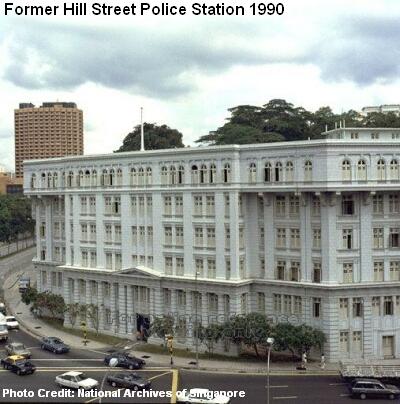 A massive $494,000 was pumped into the construction of Hill Street Police Station at the junction of Hill Street and River Valley Road. When it was completed in 1934, the six-storey Neo-Classical building was the largest police barracks in British Malaya.
A massive $494,000 was pumped into the construction of Hill Street Police Station at the junction of Hill Street and River Valley Road. When it was completed in 1934, the six-storey Neo-Classical building was the largest police barracks in British Malaya.
Designed by J.F. MacNair and mostly made of reinforced concrete, the large building consisted of a police station, staff quarters, parade ground and even playgrounds for the children of the European police officers.
Like the Central Police Station, the Hill Street Police Station was taken by the Japanese during the Second World War. It was rumoured that the Kempeitai used the offices as interrogation and torture rooms for the anti-Japanese personnel.
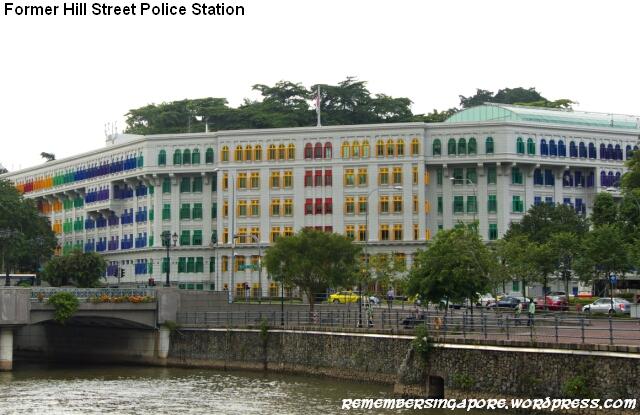
The former Hill Street Police Station was gazetted as a national monument in 1998, and became an iconic landmark with its new colourful appearance. Today, the premises are used as the headquarters of several government ministries and bodies such as the Ministry of Communications and Information (MCI) and Ministry of Culture, Community and Youth (MCCY).
Lower and Upper Barracks, Pearl’s Hill
Completed in 1934, the Lower and Upper Barracks at Pearl’s Hill were first used to house the Sikh Sepoys, one of the Straits Settlements Police’s early contingents. The married Sepoys were accommodated at the Upper Barracks, while the unmarried ones stayed at the Lower Barracks along Eu Tong Sen Street.

The first Sepoys were among the first Indians to arrive at Singapore with Sir Stamford Raffles in 1819, and were mainly stationed as infantry troops at Tanglin, Fort Canning and Pulau Brani. Known for their bravery, they were later recruited by the police. Many later settled down to form the Sikh community in Singapore today.
The Police Radio Division, with its emergency hotline ‘999’, was established at the Lower Barracks in 1948. The top floor of the building was converted in a 24-hour radio-linked operation room to attend to any emergencies. By the mid-1950s, the division was able to operate with 13 radio networks and a fleet of 60 patrol cars. Due to its strategic location at Eu Tong Sen Street, the police could easily dispatch their radio cars to islandwide operations. One tragic event that shocked the Police Radio Division was the collapse of Hotel New World in 1986, when hundreds of panic calls swarmed the communication centre that particular morning.
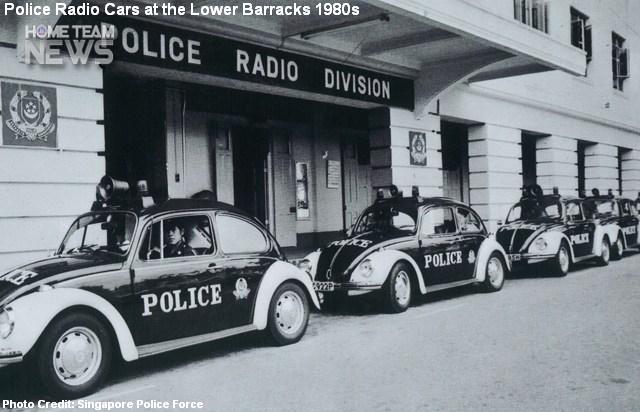
After Singapore’s independence in 1965, the Ministry of Interior and Defence (the predecessor of the Ministry of Defence and Ministry of Home Affairs) moved into the Lower Barracks, sharing the buildings with the Police Radio Division. In the seventies and eighties, several police departments such as the Criminal Investigation Department (CID), Police Licensing Division, Anti-Vice Unit and the Central Narcotics Bureau (CNB) were also relocated at the Lower Barracks. The premises were eventually left vacant after 1996.

The Upper Barracks, on the other hand, was a grand three-storey Neo-Classical building that stands on the slopes of Pearl’s Hill and watches over Chinatown. It was also occupied by the Ministry of Interior and Defence in 1965 before being converted into the Police Operational Headquarters. By 2001, all the police divisions from the Lower and Upper Barracks were relocated to the new Police Cantonment Complex.
The wall of its entrance still bears the crest of the Straits Settlements Police. Both the Lower and Upper Barracks were gazetted for conservation in 2008.
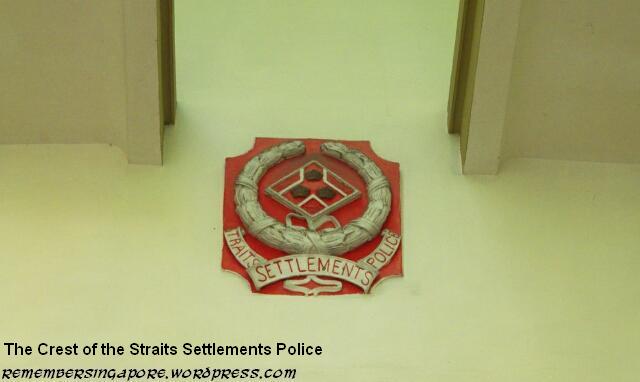
Beach Road Police Station
The former Beach Road Police Station was another police station built in the early 1930s to closely monitor the crimes in the city. It stood on reclaimed lands near the famous Alhambra and Marlborough Cinemas, where the seaside was just a few steps away behind the station. During the Japanese Occupation, the building was used as a holding area of the local Chinese, Indians and Jews before they were sent to Changi Prison by the Japanese.
Since the early seventies, the Beach Road Police Station was occupied by the Geylang Police Division and, later, the Central Police Divisional HQ. By the late eighties, it was apparent that its location was not suitable to look after the needs of the new and upcoming housing estates. The police station was eventually decommissioned in 2001, and given the status of a historic site two years later. Today, its premises serve as the campus of Raffles Design Institute.
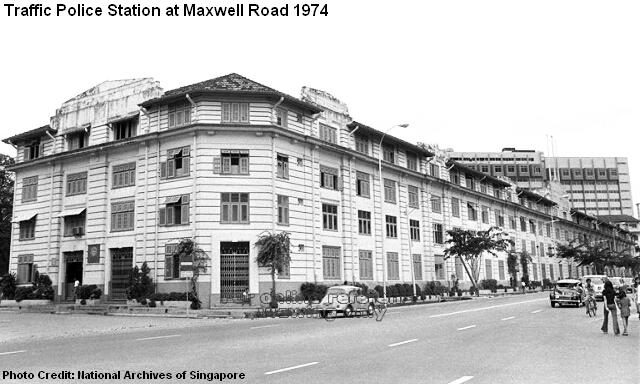
Traffic Police Station, Maxwell Road
 Constructed by the British in 1928, the grand building at Maxwell Road served as the headquarters of the Traffic Police Branch for nearly 70 years. The police station also functioned as a venue for the driving tests in the early days. In 1999, the Traffic Police Department moved to its new office at Kampong Ubi, and the building was left vacated.
Constructed by the British in 1928, the grand building at Maxwell Road served as the headquarters of the Traffic Police Branch for nearly 70 years. The police station also functioned as a venue for the driving tests in the early days. In 1999, the Traffic Police Department moved to its new office at Kampong Ubi, and the building was left vacated.
It was not until 2005 before the 100,000 square feet site was converted into a Red Dot Traffic design centre and museum. Given a fresh coat of red paint, the easily recognisable landmark of Maxwell Road was presented with the conservation status by the URA in 2007.
Detective Headquarters, Robinson Road
Perhaps the most interesting police station built in the 1930s was the Detective Headquarters at Robinson Road. Nicknamed the “hush hush” house, the three-storey building was specially designed in such a way that any preparations or consultations of police operations would be invisible to prying eyes. Hidden behind bricked walls, inspectors on missions could rapidly leave the station undetected. This helped to halt the collaboration and leakage of confidential information by the corrupted policemen.
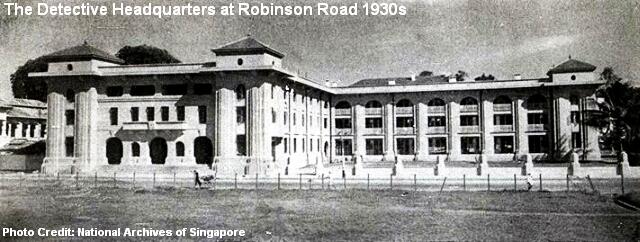
Dubbed as Singapore’s “Scotland Yard”, the Detective Headquarters set up different departments to study criminal statistics, photography, fingerprints and analysis of bullets and cartridges. Officers specialised in different Chinese dialects were recruited to combat crimes committed by the Chinese secret societies. The information collected were used to monitor illegal activities such as commercial crimes, prostitution and gambling.
Prominent Figures
 Regarded as the father of the police force in Singapore, Thomas Dunman (1814-1887) was the first Commissioner of Police between 1856 and 1871. The riots in 1854 came as one of the early tests for Dunman, who was then a Superintendent. The small police force could not cope with the widespread clashes, and military troops had to be called in. To avoid repeating the same mistake, Dunman carried out training of his police force, improving its efficiency and discipline. By also maintaining good relationships with various communities, Dunman was able to gain first-hand information of the incidents in the city. Under his leadership, there was soon a significant decline in the crime rate. To honour his contributions, Dunman Road was named after him.
Regarded as the father of the police force in Singapore, Thomas Dunman (1814-1887) was the first Commissioner of Police between 1856 and 1871. The riots in 1854 came as one of the early tests for Dunman, who was then a Superintendent. The small police force could not cope with the widespread clashes, and military troops had to be called in. To avoid repeating the same mistake, Dunman carried out training of his police force, improving its efficiency and discipline. By also maintaining good relationships with various communities, Dunman was able to gain first-hand information of the incidents in the city. Under his leadership, there was soon a significant decline in the crime rate. To honour his contributions, Dunman Road was named after him.
Famous for his campaigns against gambling and communism, René Henry de Solminihac Onraet (1887-1952) was the Inspector-General of the Straits Settlement Police between 1935 and 1939. Proficient in Hokkien and Malay, Onraet worked as an undercover in Chinatown and successfully busted the operations of many gambling dens. In 1922, after his promotion to superintendent, Onraet was tasked to monitor political threats, especially those coming from the communist organisations. He retired in 1946 and returned to Hampshire, where he died six years later at an age of 67. Onraet Road was named as a tribute to him.

Disbandment
With the Special Branch and Detective Branch well-established, the Crown Colony, by the late 1930s, boasted having one of the best police forces in the British Empire. However, all these were undone when the Japanese forces invaded and captured Singapore in February 1942. The Straits Settlements Police Force came under the control of the Japanese and all vessels owned by the Marine Police were confiscated.
After returning to the Malay peninsula at the end of the Second World War, the British decided to form a Malayan Union under a unifying administration. This led to the Straits Settlements being dissolved in April 1946. Penang and Malacca joined the Malay states to form the Malayan Union, while Singapore remained as a separate Crown Colony of the British. With the Straits Settlements no longer in existence, the Straits Settlement Police Force was disbanded.

Singapore Police Force (1946-1959)
The chaotic Singapore society was in urgent need to be stabilised after the Japanese Occupation. The Volunteer Special Constabulary (VSC) was established in October 1945 to help the police enforced law and order in the streets that were seeing the return of gangsterism and secret societies. To make things worse, Singapore was facing the infiltration of communist elements and rising racial tensions.
The strength of the local police force was dealt with a blow after its Sikh contingent was decimated in the Second World War. To make up for the losses, the Singapore police founded the first batch of Gurkha contingent in April 1949. It proved to be a crucial move as the disciplined and loyal Gurkhas maintained their neutral stand during the racial riots.
The First Policewomen
 In 1937, Shanghai deployed its first ever batch of 33 Chinese policewomen to fight crime and perversion. The surprising news had many wondered when would Singapore have its first women police. When interviewed, the Singapore Police clarified that there were no plans of recruiting women, claiming that they were not required in the country.
In 1937, Shanghai deployed its first ever batch of 33 Chinese policewomen to fight crime and perversion. The surprising news had many wondered when would Singapore have its first women police. When interviewed, the Singapore Police clarified that there were no plans of recruiting women, claiming that they were not required in the country.
This discrimination lasted until March 1949, when women were allowed for enrolment for the first time. After months of training, 10 female trainees were selected and became Singapore’s first policewomen when they signed on in January 1950. One of the trainees, Mary Quintal, went on to become the first female Assistant Superintendent of Police in 1961.
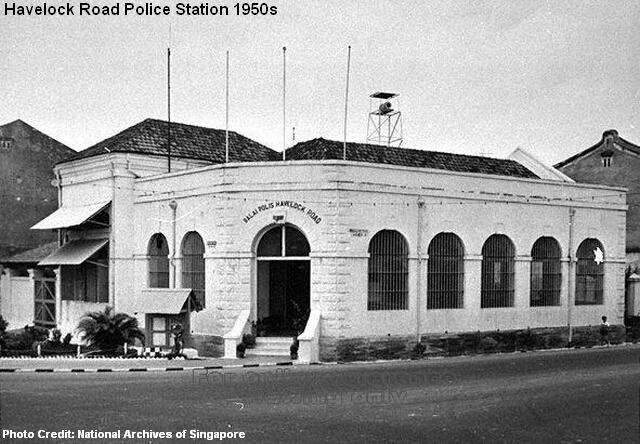
New Threats to Society
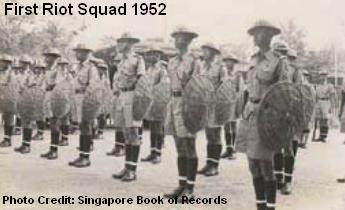
The 1950s was arguably the toughest period faced by the police force, as they had to deal with a series of social unrest in the Maria Hertogh Riots (1950), the Hock Lee Bus Riots (1955) and the Chinese Middle School Riots (1956). After the Maria Hertogh Riots, the first Riot Squad was formed in 1952. It would later become the Police Task Force well known for their distinctive ang chia (red riot control vehicles).
The basic police force in the early fifties was made up of only 3,000 constables and detectives, 2,700 of them Malay and 300 Chinese. To increase its efficiency, the police force went through a thorough restructuring in 1952. The strength of its Gurkha contingent was also doubled to deal with the increasing number of riots. At the end of the 1950s, the police force had strengthened to 4,000. More than half were Malays, with the remaining made up of Chinese, Indians, Pakistanis, Gurkhas, Ceylonese, Eurasians and Europeans.

First Police Week
The first Police Week was organised in 1958 to foster good public-police relationship. The public could visit the 12 police stations every evenings during the one-week event. More than 370,000 men, women and children, about one quarter of Singapore’s population, turned up to read the posters, listen to talks and visit the detention cells, guided by the officers and constables themselves.

The second Police Week, however, was held 13 years later in 1971.
Polis Negara Singapura (1959-1965)
Joining the Federation
As Singapore marched towards its self-governance, the police force also received a new name. The Singapore Police was renamed as Polis Negara Singapura in December 1959, represented by a new coat-of-arms with a crescent moon and five stars.
In 1961, a Police Force Amendment Bill was debated and passed in the Legislative Assembly, unifying all police units to be placed under the command of the Commissioner of Police. The Bill also approved the replacement of small individual police forces, stationed at strategic locations such as the airport, Singapore Harbour Board and the Shell Company, by the auxiliary police.
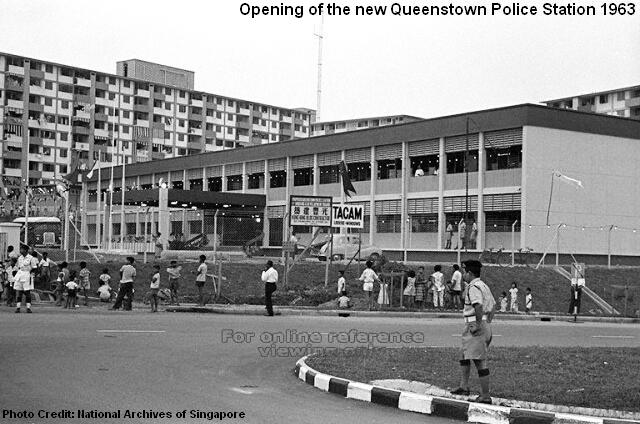
The Polis Negara Singapura was officially integrated into the Royal Malaysian Police Force in September 1963, after Singapore’s decision to merge with the newly-established Federation of Malaysia. At the ceremony held at the Pearl’s Hill headquarters, its dark blue flag was lowered, replaced by the Royal Malaysian Police Force’s navy blue flag.
Prominent Figures
 Song Kok Hoo (1906-undetermined) was the first Chinese to act as the Commissioner of Police, taking charge of the police force temporarily for two months in 1959. His appointment was taken into consideration to prepare Malayans for the top police posts after the eventual departures of the senior British officers. A 20-year-old Song Kok Hoo first joined as a probationary police officer in 1926, before rising to be the most senior Asian police officer in the force by the late fifties.
Song Kok Hoo (1906-undetermined) was the first Chinese to act as the Commissioner of Police, taking charge of the police force temporarily for two months in 1959. His appointment was taken into consideration to prepare Malayans for the top police posts after the eventual departures of the senior British officers. A 20-year-old Song Kok Hoo first joined as a probationary police officer in 1926, before rising to be the most senior Asian police officer in the force by the late fifties.
 In 1963, John Le Cain (1912-1993) became the first Asian to be appointed as the Commissioner of Police. Born in Thailand, Le Cain arrived at Singapore at age 2, and joined the Straits Settlement Police Force in 1939. A well-known Eurasian, Le Cain faced many major social issues during his tenure, such as the Indonesian Konfrontasi, racial riots and Singapore’s independence. He retired in 1967 after an illustrious 29-year career with the police force.
In 1963, John Le Cain (1912-1993) became the first Asian to be appointed as the Commissioner of Police. Born in Thailand, Le Cain arrived at Singapore at age 2, and joined the Straits Settlement Police Force in 1939. A well-known Eurasian, Le Cain faced many major social issues during his tenure, such as the Indonesian Konfrontasi, racial riots and Singapore’s independence. He retired in 1967 after an illustrious 29-year career with the police force.
20 years serving in the police force and rising to the rank of assistant superintendent, Wilfred Skinner (1936-2003) was perhaps better remembered for his sporting talents as a double international for Singapore. One of the best goalkeepers produced by Singapore in the fifties and sixties, he made his debut at age 18 and dominated the posts for the national football team for as long as 15 years. In addition, Skinner was also the half-back and captain of the hockey national team in the early sixties.

Kampong Spirit
In the fifties and sixties, the police force was mainly concentrated at the city and downtown areas. Hence, police assistance was limited in the rural regions.
 A constable was usually assigned to look after several kampong, and it would be a familiar sight to see him patrolling around on his bicycle. Most villagers would welcome the constable as he offered advice and helped to settle minor disputes.
A constable was usually assigned to look after several kampong, and it would be a familiar sight to see him patrolling around on his bicycle. Most villagers would welcome the constable as he offered advice and helped to settle minor disputes.
As population grew and kampong flourished, several police posts were erected at convenient locations in the suburban areas, such as Ama Keng, Bedok, Kampong Bahru and Kandang Kerbau. Some of the former police stations had unique names that are seldom heard today. The Wayang Satu Police Station was located at the junction of Bukit Timah Road and Stevens Road, whereas the Rumah Miskin Police Station, standing along Serangoon Road, was later converted into a halfway (rehabilitation and counseling) house for former drug addicts.
Singapore Police Force (1965-Present)
From Khaki to Blue
The local policemen first donned regular uniforms in 1856. Although the designs had gone through several changes, the colour and material used largely remained the same. By 1959, there were proposals to overhaul the design of the police uniforms to present the image of a new self-government of Singapore. The grey flannel shirt, khaki shorts and black beret were viewed as colonial products left behind by the British, and had be changed immediately. The songkok was suggested to replace the beret.
However, the makeover plan did not materialise and it would take almost another decade before the policemen were able to don their new uniforms.


The year 1969 was a significant year for Singapore and its police force. It was the 150th anniversary of the founding of modern Singapore. The Singapore Police Force, already 6000-strong by then, received a brand new design in their uniforms. A stark contrast as compared to the former colonial ones, the new dacron blue uniforms, completed with long-sleeved shirts, trousers and peak caps, would play an important role in helping the policemen maintain a professional look. The material used for the new uniforms was also well suited in a tropical climate.
The Singapore Police Force also revolutionised the ranking system. In 1972, the ranks of Lance Corporal, Corporal and Staff Sergeant were abolished. However, the move led to a lack of morale and motivation among the junior police officers. After much considerations, the ranks were reinstated four years later (but the rank of Lance Corporal, however, was again removed in 2002).
Demolition of Old Police Stations
After Singapore’s independence, the country was facing several issues such as overcrowding in the city and poor living conditions of the people. There was also a severe lack of infrastructure. In 1967, the Urban Renewal Department (URD) was set up to redevelop the central part of Singapore, and it was obvious that many of the former aging colonial police stations had to go.
The Orchard Road Police Station, standing at the busy junction of Orchard Road and Patterson Road, was high up on the demolition list. Constructed before the 1880s, it was one of the oldest buildings in the Orchard vicinity. The police station and its staff quarters, built in 1922, were eventually torn down in 1967.
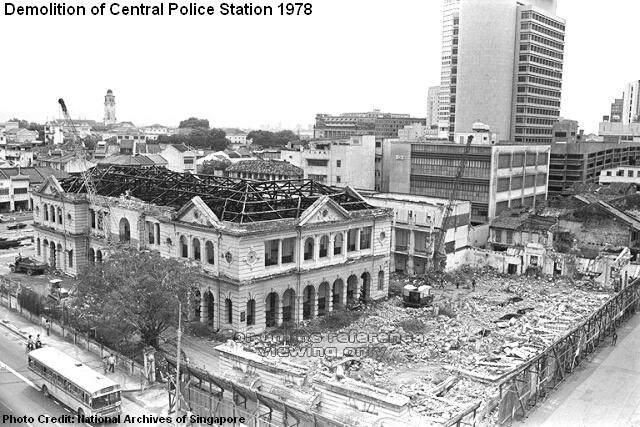
In the next decade, several other colonial police stations also faced the same fate. The Havelock Road Police Station was demolished in 1969, followed by the Tanjong Pagar Police Station in 1972. The Central Police Station, one of the biggest police stations built during the British era, was also torn down in 1978 due to the widening of Upper Pickering Street.
The Hill Street Police Station, Beach Road Police Station and Pearl’s Hill’s Lower and Upper Barracks were the only colonial police stations located in the city area that had escaped the fate of demolition.
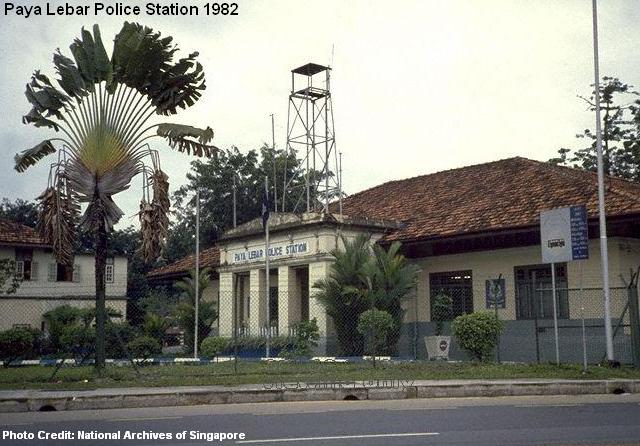
Some of those police stations located in suburban areas were also fortunate to stay on. After its closure, the premises of the former Paya Lebar Police Station were used as the headquarters of the Singapore Civil Defence Force (SCDF) and, later, the school campus of several foreign educational institutions. The former Joo Chiat Police Station, built in 1928, has been converted into a hotel and restaurant, and will likely be conserved in the coming years.

The Neighbourhood Police Posts
As new housing estates were developed in the seventies, new police stations were built within the residential areas to bring the Singapore Police Force closer to the community.
In 1983, the Neighbourhood Police Post (NPP) system was implemented in many new towns. Modeled after the Kōban system in Japan, the objective of NPP was to promote community policing. Each small police post was set up to look after its designated neighbourhood, provide assistance and interact with the residents on a regular basis. The NPP system proved to be a success, as it helped to bring down the crime rate and was well-received by the public.


However, the NPP system put a strain on the police force’s limited resources and manpower. After a review in 1997, the Singapore Police Force decided to pool the resources together to form the Neighbourhood Police Centre (NPC) to cover the eastern, western, north-eastern and central regions of Singapore. The Queenstown Neighbourhood Police Centre became the first NPC to be established. Today, there is a total of 35 NPCs in Singapore.
Published: 10 August 2013
Updated: 14 January 2018








Wow you’ve done incredible research, thanks so much! Happy National Day to you!
PS – Mata-mata the tv show sucked! You should do a post of our local Mediacorp shows and how they haven’t changed and still suck – bad acting, bad writing, bad directing! (I’m not talking about The Pupil/Code of Law or other shows which is are NOT produced by Mediacorp even if broadcasted by them – i mean Mediacorp turds!)
Hi there. You’ve made a glaring mistake in Malay. The correct term is Polis Negara Singapura. Not Polis Singapura Negara. This is a common mistake. The ampulet of the Polis Negara Singapura is abbreviated as PNS.
(Photo Credit: http://kitinsignia.tripod.com/singaporepoliceforceinsigniacollections/id8.html)
Have corrected the error… terima kasih! 🙂
If my memory is right. Do we have a Police Station called “Rumah Miskin” near the junction of Balestier and Serangoon Road?
Yes there was one at the junction .
Amazing! I commented to you last year on Police HQ and you did write it!
I was in PHQ for 2 years for NS and ORDed in 2000 before they shift. It was a fantastic place! Eu Tong Seng’s CID canteen also have very nice chicken drum sticks….
Hi, just want to share with you about the the “rural west” police station. It was called bukit panjang or kranji police station, not sure which. Location is at now ten mile junction/junction 10. There is a mini museum, not sure it if is still there at the jurong police station (jurong west ave 5) tracing the history of the police in the western region of Singapore. Do drop by as there were some pictures/artifacts in there. The mini museum is at the lobby, just beside the main entrance.
Bukit Panjang police station was the one located at the current location of 10 Mile junction. It was the Divisional HQ for Rural West Division until Boon Lay Station took over.
Thank you for mail about the police
On Fri, 15 Nov 2019 at 18:18, Remember Singapore wrote:
> Lim Seng Min commented: “Bukit Panjang police station was the one located > at the current location of 10 Mile junction. It was the Divisional HQ for > Rural West Division until Boon Lay Station took over.” >
The rank structure in 1972 undergo an overhaul with the abolishment of Lance Corporal, Corporal, Sergeant, Staff-Sergeant ranks. Only the rank of Corporal and Sergeant were retained after the restructuring and the Lance Corporal was never introduced back again .
This posting reminds me of a close and good friend, Police Inspector Azhari from Beach Road Station, who transported me to my place of work at Guillemard Malay School in a police vehicle where he thought I would be safer. It happened during the spill-over of a communal riot in Singapore in 1969.
My reason for writing is to seek help from anyone who knows the whereabouts of Mr Azhari. I would be truly grateful. I can be contacted at: singapore60smusic.blogspot.com
That’s heartwarming… Thanks for sharing this story of yours 🙂
Thank you for the immediate response. My one hope is for someone to write in, that certain someone who knows where I can find Azhari. I tried to but in vain.
Another great post (and specially useful for some fiction I’m working on). This is a great site. I was born in Singapore in 1960 and lived/visited frequently until my father retired from SIA in 1985.
Would be interested on you doing a history of the ‘colonial’ clubs (SSC, Island, Tanglin, etc.) and the indigenous equivalents (e.g. Chinese Swimming Club in Katong).
Again, I appreciate your work on this site. Other subjects that might be interesting is an overall history of public housing–from colonial, HDB, and privatization–and road/transport development. Thanks.
I was born in Singapore in 1960 Paya Lebar Police Station that was the happy time.
Gosh i am amazed with the amount of facts and historical pictures you put up. Must been a lot of research and effort. Thumbs up. Bookmarked and will recommend friends for their reading pleasures. Keep up the good work!
My dad , Maurice Oh was in the Police Force from the 50s to the early 80s. We used to live at Police Academy , indeed those were the good old days!
Changes in the Police crest over the years from 1800s till today

(Source: http://www.spf.gov.sg/abtspf/history.htm)
Hi! nice post. I am interested to find out more about the colonial police posts. Could you say something about where you got most of your information from?
Who knows what was the training attire like back in 1965?
wonderfullly writen. Thanks. Can I ask how I can trace someone who was in the Singapore Naval Police? a
Nice posting about the history of Singapore Police Force. As a retired corporal, your writing bring back some nice memories in the 70’s and 80’s where I witnessed the transformation of my policing area from kampongs/semi forest into concrete jungle of today.
One memorable day of duty at a then rural police post in May 1981 where the cortege of the late President Sheares travelled past for state burial ground at Kranji and I was standing outside the post saluting.
The photograph showing Kandang Kerbau Police Station must have been taken in the early 1950’s not in the 1960’s because when I came from India in July 1959 the sheds were not there and KK Hospital new wing facing Bukit Timah Road was already built. I spent 3 years staying in KK Quarters and in Belilios Lane. We used to frequently pass by the Police Station . There used to be a notice board, announcing rewards for information about crimes, in front of the Police Station along Serangoon Road.
Nice to see how Malaya’s (now Malaysia) used to be multiracial…
Valuable input from a reader Lian:
“There was mention about the first Local Deputy Commissioner, one Mr Song Kok Hoo. He was born in 1906 but his date of death was marked unknown.
His name does appear in the Singapore Free Press and Straits Times from the 1920s to the 1960s. This would probably indicate that he was a pretty famous policeman during the above mentioned period.
I have seen some old newspaper clippings that mention the above officer:
1) He graduated from Raffles Institution in 1925. This was mentioned in the Singapore Free Press, page 7, 7 April 1925. He attained the Special Malayan Certificate.
The link has been pasted below: http://eresources.nlb.gov.sg/newspapers/…/singfreepressb19250407.2.52.aspx
2) A second mention of him as an investigation officer in a court case. This was mentioned in the Straits Times, 29 July 1931. This case was a murder case. In the old days until the 1990s, the position of an Inspector and an Asiatic one is considered to be a very big position. They would serve as an Inspector for years, even decades before being promoted to the next rank higher rank as an Assistant Superintendent of Police.
The link has been pasted below: http://eresources.nlb.gov.sg/newspapers/…/straitstimes19310729-1.2.91.aspx
3) The third mention of him is him involved as a Protestant in Church Services. He was involved in Malay Language Services. The newspaper edition is the Straits Times dated 17 July 1937.
The link has been pasted below: http://newspapers.nl.sg/Digitised/Article/straitstimes19370717-1.2.123.aspx
4) The next mention of him is his engagement ceremony which was published in the Singapore Free Press, 6 October 1931.
The link has been pasted below: http://eresources.nlb.gov.sg/newspapers/…/singfreepressb19311006-1.2.98.asp
5) There is also mention of him attending Song Ong Siang’s funeral in 1941.
The link has been pasted below:
http://eresources.nlb.gov.sg/newspapers/Digitised/Article/singfreepressb19411001-1.2.61.aspx
There is no public mention of him during the war years. From these snippets, a possible biography of the first senior Asiatic officer in the Singapore Police Force:
1) He is probably a Peranakan Baba and speaks Malay and English.
2) He is from an upper class background as seen in his educational qualifications. His education achievements would have been very high in the 1920s and 1930s. Not many could afford to go to schools in those days.
3) His engagement was announced in the public. Does this indicate being in the upper classes?
4) He is probably a Peranakan Christian as seen in being involved in Church Activities.
5) He would have known Song Ong Siang. I am not sure if they are related in any manner.
After the war years, he was the first Asian officer to be promoted to ASP rank in 1949. He continued rising until being made acting Commissioner of Police in 1959 for two months. After which, he went back to being Deputy Commissioner of Police. He would serve in this capacity until retirement in 1962. He was then appointed to being Security Chief of one Japanese oil refinery in Singapore.
After the last report of him in 1962, there is no mention of him in our local papers. The only mention of him comes in one website. The website mentions one Song Kok Hoo who was born in 1907 and passed away in Richmond, Australia in 1985. This person seems to match the police officer as the names of his parents was provided.
His father’s name does match the name in his engagement newspaper announcement.
The link has been pasted below:
http://www.ancientfaces.com/person/kok-hoo-song/147003132
After independence, there was a movement of Eurasians, Peranakans and English educated people to Australia. There are Singaporeans who have done that like T JD Campbell and Lloyd Oscar Valberg.
I must caution that all these information are based on deductions and assumptions.
The Criminal Intelligence Department was the predecessor of the Special Branch. It was renamed to the Special Branch in 1932. The focus of the Special Branch was political policing. This sphere is entirely From the 1920s to the 1930s, it was at the forefront of battling communism and anti-colonialism. The Special Branch will only look into the matter if it was deemed to be subversive and political. Until 1967, it was organizationally part of the Singapore Police Force. The head of the Special Branch was almost always a Deputy Commissioner of Police and the sub divisions were headed by Superintendents.
The Special Branch later became the Internal Security Department when it was detached from the Singapore Police Force in 1967 to become a separate organization in the Ministry of Home Affairs. The Criminal Intelligence Department should not be confused with the Criminal Investigation Department. The Former did not do criminal investigation work. Its focus was on political policing. The local men that were in the Special Branch were detective constables, Sergeants and Inspectors. These men were specially selected, not unlike, how the best officers were seconded or sent to CID. The men involved with the Special Branch were of even higher caliber than CID officers. The skills required in Political Policing were very different from criminal policing. It required overt policing and cultivation of informers. Special Branch officers and men always operated in the shadows as their nature of work requires it.“
Sharing another well-researched feedback from Lian:
“Just to share a little more information with you about the Deputy Police Commissioner, Mr Song Kok Hoo.
There was further mention of him post war.
He is a married man and had children. There was a Memoriam placed in the Singapore Straits Times in 1974. It was placed by Song Kok Hoo and his family in memory of his wife, Madam Rosaline Lee Sian Eng.
The link has been attached for your reference:
http://eresources.nlb.gov.sg/newspapers/Digitised/Article/straitstimes19741120-1.2.122.aspx
He was also involved in Church activities as a young person. The link has been attached for your reference:
http://eresources.nlb.gov.sg/newspapers/Digitised/Article/singfreepressb19330805-1.2.13.aspx
http://eresources.nlb.gov.sg/newspapers/Digitised/Page/singfreepressb19270105-1.1.18.aspx
It seems after his retirement from the Singapore Police Force, he was involved in church activities as an elder in the Presbyterian Church in Singapore. The PDF document has been attached. It is in English and Chinese.
If you do like to find out more information Mr Song Kok Hoo, you may want to write to the following Presbyterian Church for any further leads about our first local police commissioner.
Church Name: Jubilee Presbyterian Church
URL: http://www.jubilee.org.sg/our-church/history/
General Enquiry 电邮询问: Ms. Sally Ong admin@jubilee.org.sg
Just puzzled about a point, the Singapore Police Force Museum has a collection named after John Le Cain. There is no mention of Song Kok Hoo. His Alma Mater, Raffles Institution, have remembered David Saul Marshall, who was in the same batch as him. His Alma Mater seemed not to have remember about Mr Song Kok Hoo, who being the first Asian Inspector, Assistant Superintendent of Police and Commissioner of Police would definitely have accomplishments that would be worth mentioning.
I not too sure if his descendants are still in Singapore. The Presbyterian Church may be able to help you link up to people who would have known him.
The Special Branch Chinese name would reveal in its true sense about the department’s policing purpose. In the English Langauge, the title: “Special Branch” does not indicate its true purpose. If we look at the Chinese title: “政治部”. The literal translation means the Political Bureau.
The Chinese name is crystal clear about the Department’s role and concern. The Singaporean Special Branch later became the Internal Security Department (ISD). The Royal Malaysian Police Special Branch still retains the original title and is organizationally still part of the Royal Malaysian Police and staffed and headed by Police Officers. The Internal Security Department was detached from the Singapore Police Force and placed directly under the Ministry of Home Affairs. The ISD is still staffed by Police Officers and transfers still do happen from the Police Force to the ISD. The relationship between the Malaysian Special Branch and the Internal Security Department still exist which dates back to the Colonial Era.
Historically, all Police Forces are and still concerned with Political Policing/High Policing. I would need to emphasize that all information here are solely from an historical perspective.
There will always be fringe groups that would want to overturn the existing political system of the country. I will cite Malaysia as an example. In Malaysia, if any group were to push for the abolition of the Monarchy and Royalty coupled with the overturning of the parliamentary system, it would be seen as subversive and seditious. Any attempts to question the rights of the native peoples, the Bumiputera, will be construed as Sedition and Subversive. It is akin to challenging the existing political system. These groups will be come under the attention of the Malaysian Special Branch. High Policing is not the same as Overt Policing (Police Patrols). High Policing and Covert Policing (i.e, CID) involves undercover policing and plain clothes policemen infiltrating the target groups etc. Any attempts to stir racial discord would fall under the purview of political policing.
High Policing also deals with counter espionage. The skills required for these type of policing (Political/Counter Espionage etc) requires a different breed of Police Officers that are a cut above CID officers. The Analytical and intellectual skills for analysis, informant running, and investigation are a step higher than those from the CID. The cases that the officers work on are very much like chess pieces and form part of a larger picture. These officers would need to have an intuitive sense of the world that they are policing. More often than not, High Policing is not about the numbers of persons arrested or proceeds of the crime that was sized. It is about nipping in the bud any subversive activity before it could bear fruit.
High Policing is very much in the shadows. The participants in this game would have a very clear view of the undercurrents in Society. The Former Police Academy has a road called Wong Chin Yoke Road and Onaret Road. These two men were at the forefront of combating communist subversion in the 1920 to early 1940s Pre War Singapore.
After World War 2, these security concerns are still loom large on the minds of the Colonial Authorities. Both the Colonial Authorities and their successors, The Federation of Malaysia and Singapore Governments was very much be concerned about external attempts to subvert the country through external support (From China and Comintern) to the Communist movement in Malaysia and Singapore.
Communism has collapsed. However, in the minds of the Security Branches, communist activities would have loomed large in their security concerns during the cold war.
I must reiterate that these are my personal views on history. If you do want to find out more about this part of history, you may want to refer to the following writers, Leon Comber and Lim Kah Choon. They have written about the High Policing in Singapore.
Alternatively, you may want to interview Special Branch Veterans like Yeong Siew Wah. The National Archives does contain audio recordings of the various interviews conducted with retired police men and Special Branch Head, George Boggars.
Please do check the facts with other sources like newspapers, archives and interviews etc if you do want to publish/print them. I may be inaccurate in my facts. I have to caution that I may be wrong in my facts.
I must reiterate that these are my personal views on history. If you do want to find out more about this part of history, you may want to refer to the following writers, Leon Comber and Lim Kah Choon. They have written about the High Policing in Singapore. Alternatively, you may want to interview Special Branch Veterans like Yeong Siew Wah.
Cheers!
Lian“
I have a landscape picture of the Inspectors / Senior / Above entitled Inspectorate, Singapore Component, Royal Malaysia Police dated 4 th March 1965. This was taken at P T S aka Old Police Academy. If anybody or organisation want it, please let me know. I m @ maurice12oh@gmail.com.
Bukit Timah Police Post 1980s
(Source: Facebook Group “十里之外”)
Bukit Timah Police Post was once known as Bukit Timah Police Sub-Station under the jurisdiction of ‘E’ Division or Orchard Road Police Station. It was re-named Bukit Timah Police Post in the early 1980’s when the ‘E’ Division HQ shifted from Orchard Road to Tanglin Police Station at Napier Road where the new INTERPOL building is now located . When it was still known as Sub-Station, there was a Police Post under its jurisdiction located at Jurong Road 10 m.s ( present day Bukit Batok HDB estate) known as Jurong Police Post.
I was a young constable assigned for duties at Bukit Timah Police Sub-Station between 1978-1982. Originally there were 2 constables (PC) on duty on the each rotating shifts of ‘A’ Shift-7am-3pm, ‘B’ Shift -3pm-11pm and ‘C’ Shift or the graveyard shift -11pm-7am next day. The shift changes every day with the 4th day being the day off. The In-Charge of the Sub-Station was a Sargent but after a few months of my posting, a Corporal was assigned to be the In-Charge. At that time, there were 10 officers reporting at the Bukit Timah Sub-Station . The Sargent and later the Corporal and one constable who was on duty at Jurong Police Post works normal office hours. The constable on duty at Jurong Police Post will report for duty at Bukit Timah Sub-Station and after drawing his equipment will proceed to Jurong Police Post by public transport.
Apart from some unpleasant experiences during the graveyard shifts or few historic event whilst I was on duty such as when the Beauty World was razed down by huge fire and saluting outside the station when the hearse of the late President Sheares travelled past heading towards Kranji State Cemetery, one incident which is still fresh in my memory is the following:
I think it was sometime in 1982 after the Sub-station was re-named Bukit Timah Police Post and it’s manpower was reduced to half. Myself, the officer in the photograph and 2 other constables were retained and continue performing one man duty on each shift. One Sunday morning, the Commander of the division paid a visit & inspection at the Post while I was on duty. Upon checking the armoury , the Commander was furious upon discovering that I was boiling water in a big ‘gayong’ or tin mug with the electric coil. This was the time before you have the 3-In-1 coffee mix so the Commander was speechless when he also saw a tin of Milo, sugar container and the triangle carton Magnolia fresh milk with some biscuits. You see police posts build before the 2nd World War was not installed with many power points and therefore I used the only power point available in the armoury which was meant for the walkies-talkies charger to boil water. Why so silly boiling water in the armoury , why don’t just buy you may ask. Although at that time the Bukit Timah Hawkers Centre was already in business after the big Beauty World fire and there were two Indian restaurant/coffee shop ( Udaya Restaurant) along Bukit Timah Road opposite the police post, we can’t leave our position to buy food or drinks. You can be charged for absent of duty !
So going back to the Commander’s discovery of me boiling water in the armoury, he also decided to check what other hanky -panky going on within the police post compound. As luck was against me that day, a herd of ‘kambing kacang’ or billy goats decided to have a picnic in the post fenced compound! At that time, there was a kampong and Public Works Dept.(PWD) staff quarters located behind the police post. The billy goats belongs to one of the residents.
The Commander was livid upon discovering the intrusion of the goats into the police post compound. I think you all know the end of the story. As punishment for boiling water in the armoury , I was ordered to round up the goats, trace the owner and report to the Commander the first thing on Monday morning!
A comical scene was played within the Bukit Timah Police Post compound/field to the hilarious pedestrians/crowds outside the post when a police officer in full uniform and weapon running and chasing after some goats! As I don’t have ropes or fencing to secure the goats, I think you all also know where I keep the goats! Yes, I secure them in our lock-up! Can you imagine the scene, noises from the bleating of 8-10 goats locked-up in the police post! Fortunately for me, the owner of the goats turned up just before I reported off duty and after obtaining his full particulars and jokingly told him that he might not be so lucky the next time as his goats will end up at the Bukit Timah Hawkers Centre/Wet Market butcher , I released the goats to him and of course after he cleaned up the mess his goats made inside the lock-up.
That memory is still fresh in my mind even after more than 30 over years. I am glad to retire from the SPF with honours and promotions. To my Commander then, Thank You Sir for the punishment! To my friends & colleagues from Bukit Timah Police Post then who are reading this, now you all know why I was posted back to the ‘E’ Division HQ. Cheers!
You were the officer in the photo? Wow, that’s amazing coincidence!
Don’t miss this year’s SG50 National Day Parade with the police contingent in their vintage uniform!
I have just, in auction, bought a freestanding SHIELD of the GURKHA CONTINGENT ROYAL MALAYSIA POLICE SINGAPORE with the SCHOOL OF HEALTH 1964 at the bottom.
Research has led me to your website.
Is this of any interest to anyone associated..?..I will probably put it on Ebay to see if there is any interest if I don’t hear through this website
Thanks and regards…..very interesting blogs!!
Forgive me for suggesting, but if you get no takers you could offer it to the Gurkha Museum in Winchester (see: http://www.thegurkhamuseum.co.uk).
I remember the Port of Singapore Authority Police, too. Are they still independent or now part of the Republic’s Police?
Some good chaps who were always happy to have a chat at the gates on exit…if not too busy..
The Police Training School was elevated to the Police academy in 1969. This place, known as the ‘Old Police Academy’, is currently undergoing demolition to make way for an MRT station. Many fondly remember its swimming pool that was permanently closed on 1 April 2015.
(Source: http://www.iremember.sg/)
Police mark 200 years: Ex-traffic cop recalls high-speed chases to nab hell riders on Lim Chu Kang ’40 tiang’ stretch
07 February 2020
The Straits Times
The retired police officer’s face lit up when he spoke about police motorcycles and hell riders of the 1970s and 1980s.
Senior Station Inspector 2 Nasir Said, 65, a former Traffic Police officer and trainer, recalled high-speed chases and waiting in cemeteries to ambush hell riders who raced their motorbikes along Lim Chu Kang’s famed “40 tiang” stretch. Tiang in Malay means lamp-posts.
The long hours of waiting meant that officers like him often became targets for blood-sucking insects, said Mr Nasir, who joined the Singapore Police Force in 1972.
But his 32-year career, which was followed by another 13 years of re-employment, nearly ended prematurely. He contemplated leaving the force after the death of a squad mate in 1983 during a night escort mission.
“I was very shocked,” said Mr Nasir, who is one of the guides for the SPF200 exhibition at the National Museum Singapore.
“He was close to me… we were brought up together. He was the one who had encouraged me to join the mobile squad.”
Mr Nasir had been leading the escort of a small RSAF aircraft when his colleague at the rear of the convoy hit a divider and crashed into one of the airplane’s wings.
The officer, who was from the same village in Jalan Kubis (now Ubi) as Mr Nasir, died of a broken rib puncturing his heart before he arrived at the hospital. But Mr Nasir did not know then as there was no physical bleeding.
After being told of his friend’s death at the hospital, he became distraught and was unable to convey news of the accident to the man’s family. Mr Nasir’s senior officers understood his predicament and allowed him to take a break during that difficult time. Till this day, he is grateful and said he cannot forget the support from his family members and supervisors.
https://www.straitstimes.com/singapore/ex-traffic-cop-recalls-high-speed-chases-to-nab-hell-riders
Singapore police switching to Glock pistols after two decades of using Taurus revolver
22 June 2021
Channel NewsAsia
The Singapore Police Force (SPF) officially confirmed on Tuesday (Jun 22) that frontline officers will now use the new Glock 19 Gen 5 pistol, replacing the standard issue Taurus M85 revolver.
Since as early as 2017, officers have been progressively trained to use service pistols due to the “heightened security climate”, SPF said on its website.
Here’s how the force’s use of firearms has evolved in recent decades:
WHICH SIDEARM HAS SPF BEEN USING?
In 2002, the SPF replaced its Smith & Wesson revolver with the Brazilian-made Taurus M85 revolver to “keep up to date with modern policing needs”.
The revolver features a five-chambered cylinder, meaning it can hold five rounds, and a speed loader to reduce the time and effort needed to reload the weapon.
Firearm news site The Firearm Blog reported in 2019 that SPF officers were generally issued with 10 rounds.
Another website, GUNSweek, said the Taurus M85 revolver is an “easy-to-handle personal defence gun”. The revolver is also intended for short-distance use, at usually “well below” 5m, it added.
WHAT IS THE DIFFERENCE BETWEEN A PISTOL AND A REVOLVER?
A revolver contains a revolving cylinder in which rounds are loaded, while most pistols have a removable magazine into which rounds are loaded.
Defence website The National Interest reported in 2017 that one advantage of the revolver is that it is “easier to operate and learn to shoot”.
“There isn’t much to shooting a revolver: Simply open the cylinder, insert bullets, close the cylinder and pull the trigger,” it said.
“This simplicity is reassuring in a high-stress situation, where the user does not have to worry about whether or not the first round was chambered by racking the slide, like in semi-automatic pistols.”
Despite that, the website said a revolver’s disadvantages include the fact that they are limited to typically six bullets. This is usually less than half compared to in semi-automatic pistols, it said.
“In many modern gun engagements, the handgun owner often expends the entire magazine of 15 or so rounds in the first two seconds,” it added.
WHY IS SPF REPLACING REVOLVERS WITH PISTOLS?
SPF said on Tuesday that the Glock Gen 5 pistol can carry up to three times more rounds compared to the Taurus M85 revolver.
“This reduces reloading time, improves firepower and further augments the SPF’s ability to engage armed attackers in dealing with security threats,” SPF said.
The Glock 19 Gen 5 9mm pistol’s magazine has a standard capacity of 15 rounds, with an option for up to 33 rounds, the American gunmaker’s website said.
The 9mm measurement refers to the internal diameter of the pistol’s barrel, corresponding to the size or calibre of the rounds it can hold.
SPF also said on its website that the pistol can be used with different grip methods and features a safety mechanism that prevents accidental triggering.
Glock will supply 6,000 new duty pistols to the SPF, The Firearm Blog reported, with the company’s president Gaston Glock quoted as saying that the SPF’s trials of the pistols were “extremely professional”.
“It’s also been one of the very few tenders that’s not only evaluating technical performance and purchase price, but actual through life cost,” he added. “We’re honoured to supply such a reputable customer.”
WHAT OTHER LAW ENFORCEMENT AGENCIES USE THE GLOCK PISTOL?
ABC News reported in 2019 that the US Secret Service is moving forward with plans to outfit its agents with the Glock 9mm pistols.
This is part of a larger move among US law enforcement agencies towards the lighter, more efficient guns, the report said.
Other US security agencies making the same switch include the Federal Bureau of Investigation, US Customs and Border Protection and numerous big city police departments, including the New York Police Department and the Los Angeles Police Department.
US military website Sofrep said in 2018 that US law enforcement agencies seem to be making the move back to 9mm pistols from larger calibre weapons to take advantage of “new technologies” being applied to 9mm rounds.
“These organisations are providing their armed personnel the best chance of surviving a deadly force encounter since they can expect faster and more accurate shot strings, higher magazine capacities (similar sized weapons) and all of the terminal performance which can be expected from any law enforcement-calibre projectile,” it said.
WHEN WILL SPF OFFICERS BE TRAINED TO USE THE GLOCK PISTOL?
All frontline regulars will be trained to operate the Glock 19 Gen 5 pistol by the end of 2023, said SPF.
SPF has not offered details on how different its pistol training is, but in October last year, it showcased an improved firearm training system for its officers.
The system also shows where the round hits the target board and automates the scoring.
The SPF has been trialling ELFRAS since June last year with about 200 first-time shooters undergoing pistol and revolver training at the Home Team Academy live firing range.
https://www.channelnewsasia.com/news/singapore/singapore-police-spf-switch-glock-pistol-taurus-revolver-15067064
A patrol car (Nissan Sunny) stationed outside a Neighbourhood Police Post (Teck Ghee), 1988
(Source: Singapore Police Force Facebook)
Hi, I was a PC attached to the Airport Police at Paya Lebar Airport and I have a photo of myself behind a “Black and White” Volkswagen Beetle.
Would you be interested to have it?
Cheers
Noel Christie Danker
Thanks for sharing your photo! 🙂
(Photo Credit: Noel C Danker (Retired 1995))
Hi nice readiing your post